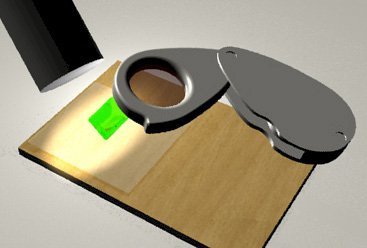Basic Analysis of a True Emerald
How to do a basic analysis of an emerald.

The price
One of the most important aspects, which must be evaluated first, is the value of the gem.
As in any other type of commercialization, gem prices vary by merchant and locality.
Do a lot of research before you buy. The market itself establishes price levels.
When you receive a price offer far below the market - be wary, nobody works miracles.
Price is the first factor that can establish the legitimacy of a gem.
Examining the gem
Using the magnifying glass

Visits to events, inside and outside Brazil, can bring many opportunities in the purchase of gems. Another situation is the visit to mining areas, which is quite common.
In this situation it is very important to know how to evaluate the gems and pay a fair price for them.
This article aims to clarify the use of two basic tools that can help a lot.
But, we advise you to know a little more about gemology or to hire a gemologist.
A good gemology course can help a lot in these situations.
Goldsmith loupes are an important resource for assessing what is inside a gem. Here we are indicating a magnifying glass with 10X magnification, however there are magnifiers with more magnification.
Natural gems will always have tiny internal defects, irregular patterns and formation marks. Be wary if a gem is totally free from these irregularities.
In emeralds, for example, check for bubbles. The natural ones have no air bubbles.
Whenever doing this type of analysis, the magnifying glass should be close to the eyes and the gem should be spaced out until focus is obtained.
Whenever possible, make this analysis with the lighted gem.

Using the chelsea filter

This filter was created in the early 20th century in England, initially used at the University of Chelsea. Its initial function was to separate the emeralds from the green beryls.
As in the group of beryls are included: emeralds, aquamarine, precious beryl, chrysoberyl, spinel, topaz and, some of them have green tones, the chelsea filter allowed this separation.
At that time, only chrome colored beryls were considered emeralds and vanadium colored ones were considered another type of beryl. Since emeralds had a high value, it was important to separate them from other types of beryl by means of a simple and accurate test - the chelsea filter.
At that time, chromium-colored beryl (emerald) had a reddish hue when analyzed with the chelsea filter, which was not the case with vanadium-colored beryl.
Over time it was realized that that small instrument could separate many other natural gems from imitations. However, it is important to remember that the chelsea filter is an additional tool and should not be used as a diagnostic tool, as it requires a more complete gemological analysis. It serves well for the situations mentioned.
How does it work?

As its name says, it is a light filter. It allows only certain colors, yellow-green and red to be transmitted, that is, seen (filters out the others).
Gems that do not transmit yellow-green or red colors will be seen as a dark image.
Seen through the chelsea filter a real emerald will appear yellowish or reddish.

Seen through the chelsea filter, a fake emerald will appear grayed out.

Looking at a synthetic emerald with the chelsea filter it will look real because in its composition there is also chromium and it has all the physical and chemical characteristics of the natural.
However, in the synthetic ones the brightness of the red is more intense.
More experienced gemologists recognize the synthetic because it contains a greater amount of chromium making it much more luminous.
If in doubt, further gemological tests will be necessary for this assessment.


